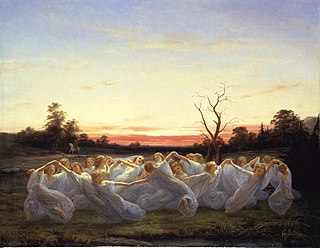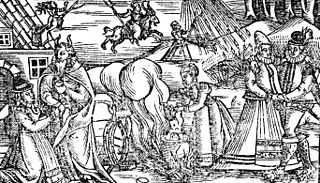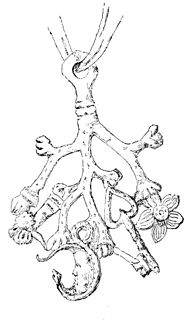
An elf is a type of humanoid supernatural being in Germanic mythology and folklore. In medieval Germanic-speaking cultures, elves generally seem to have been thought of as beings with magical powers and supernatural beauty, ambivalent towards everyday people and capable of either helping or hindering them. However, the details of these beliefs have varied considerably over time and space, and have flourished in both pre-Christian and Christian cultures.

A fairy is a type of mythical being or legendary creature found in the folklore of multiple European cultures, a form of spirit, often described as metaphysical, supernatural, or preternatural.

Isobel Gowdie was a Scottish woman who confessed to witchcraft at Auldearn near Nairn during 1662. Scant information is available about her age or life and, although she was probably executed in line with the usual practice, it is uncertain whether this was the case or if she was allowed to return to the obscurity of her former life as a cottar’s wife. Her detailed testimony, apparently achieved without the use of violent torture, provides one of the most comprehensive insights into European witchcraft folklore at the end of the era of witch-hunts.

A charmstone, charm-stone or charm stone is a stone or mineral artifact of various types associated with various traditional cultures, including those of Scotland and the native cultures of California and the American southwest. Typically they are elongated or cylindrical and have been shaped by grinding or other human activity, and may be perforated and/or grooved. They are thought to have been regarded as having some religious or magical function, including being talismans, amulets or charms.

An arrowhead or point is the usually sharpened and hardened tip of an arrow, which contributes a majority of the projectile mass and is responsible for impacting and penetrating a target, as well as to fulfill some special purposes such as signaling.
Fairyland in English and Scottish folklore is the fabulous land or abode of fairies or fays. Old French faierie referred to an illusion or enchantment, the land of the faes. Modern English fairy transferred the name of the realm of the fays to its inhabitants, e.g. the expression fairie knight in Edmund Spenser's The Faerie Queene refers to a "supernatural knight" or a "knight of Faerie" but was later re-interpreted as referring to a knight who is "a fairy".

In some cultures, the foot of a rabbit is carried as an amulet believed to bring good luck. This belief is held by individuals in a great number of places around the world, including Europe, China, Africa, and North and South America. In variations of this superstition, the donor rabbit must possess certain attributes, such as having been killed in a particular place, using a particular method, or by a person possessing particular attributes.

The cimaruta is an Italian folk amulet or talisman, traditionally worn around the neck or hung above an infant's bed to ward off the evil eye. Commonly made of silver, the amulet itself consists of several small apotropaic charms, with each individual piece attached to what is supposed to represent a branch of rue—the flowering medicinal herb for which the whole talisman is named, "cimaruta" being a Neapolitan form of cima di ruta: Italian for "sprig of rue".
"Wið færstice" is an Old English medical text surviving in the collection known now as Lacnunga in the British Library. "Wið færstice" means 'against a sudden/violent stabbing pain'; and according to Felix Grendon, whose collection of Anglo-Saxon charms appeared in the Journal of American Folklore in 1908, “the charm is intended to cure a sudden twinge or stitch, possibly rheumatism that can be due to being shot by witches, elves, and other spirits that fly through the air.” Scholars have often sought to identify this as rheumatism, but other possibilities should not be excluded. The remedy describes how to make a salve, but its main interest lies in the unique charm which follows. This describes how the færstice has been caused by the projectiles of 'mighty women', whom the healer will combat. The charm also mentions elves, believed responsible for elfshot, and provides the only attestation outside personal names of the Old English form of the name of the old Germanic gods, known as the Æsir in Norse mythology.

Omamori are Japanese amulets commonly sold at Shinto shrines and Buddhist temples, dedicated to particular Shinto kami as well as Buddhist figures, and are said to provide various forms of luck or protection.
A thunderstone is a Prehistoric hand axe, stone tool, or fossil which was used as an amulet to protect a person or a building. The name derives from the ancient understanding that the object was found at a place where lightning had struck.

An Alp is a supernatural being in German folklore.
Brazilian mythology is the subset of Brazilian folklore with cultural elements of diverse origin found in Brazil, comprising folk tales, traditions, characters and beliefs regarding places, peoples, and entities. The category was originally restricted to indigenous elements, but has been extended to include:
"Lady Isabel and the Elf Knight" is the English common name representative of a very large class of European ballads.
A good luck charm is an amulet or other item that is believed to bring good luck.

Gris-gris, is a Voodoo amulet originating in Africa which is believed to protect the wearer from evil or bring luck, and in some West African countries is used as a method of birth control. It consists of a small cloth bag, usually inscribed with verses from an African ancestor containing a ritual number of small objects, worn on the person.

Elfshot or elf-shot is a medical condition described in Anglo-Saxon medical texts, notably Wið færstice, and believed to be caused by invisible elves shooting invisible arrows at a person or animal, causing sudden shooting pains localised to a particular area of the body. Modern diagnoses might include rheumatism, arthritis, muscle stitches or cramps. Similar concepts existed in other northern European cultures.
Edward Lovett was an English folklorist, recognised for his collections of charms, amulets, and objects used in children's games.

Anglo-Saxon Amulets and Curing Stones is an archaeological study of amulets, talismans and curing stones in the burial record of Anglo-Saxon England. Written by the Australian archaeologist Audrey Meaney, it was published by the company British Archaeological Reports as the 96th monograph in their BAR British Series. Prior to writing the work, Meaney had published several books dealing with Anglo-Saxon burials.












